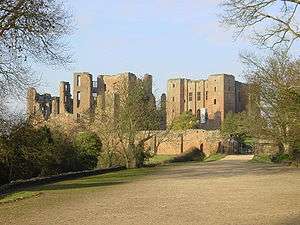Siege of Kenilworth
The Siege of Kenilworth (June–December 1266) was a six-month siege on the Kenilworth Castle and a battle of the Second Barons' War. The siege was a part of an English civil war fought from 1264 to 1267 by the forces of Simon de Montfort against the Royalist forces led by Prince Edward (later Edward I of England).
| Siege of Kenilworth | |||||||
|---|---|---|---|---|---|---|---|
| Part of Second Barons' War | |||||||
 Kenilworth Castle | |||||||
| |||||||
| Belligerents | |||||||
| Royalist forces | Baronial forces | ||||||
| Commanders and leaders | |||||||
|
| |||||||
| Strength | |||||||
| unknown | c. 1,200 | ||||||
| Casualties and losses | |||||||
| unknown | unknown, all survivors captured | ||||||
The siege was one of few castle attacks to take place during the war.[1]
Castle defences
The Castle of Kenilworth's structure was unique and contributed to the longevity of the siege.
The castle was a formidable structure due to its heavy defences.[2]
The most notable defence was a dam to the south of the castle, across which a causeway led from the entrance to the bailey and keep. Behind the dam was an artificial lake along the south and west sides of the castle, protecting it from a land approach. Ditches along the north side and a second pool on the east side of the causeway extended the water protection to surround the castle. They would also pour hot tar on the soldiers below. [2]
Siege
The feudal summons for the siege was pushed back from December 1265, finally occurring on 21 June the next year. From that point on, the siege occurred in earnest. The castle's garrison was large, over a thousand,[3] usually estimated at twelve hundred men, and active in defending themselves.[4] Outside of the castle was the feudal host of England as summoned by Henry III, along with his sons, the Lord Edward and Edmund, who had been attempting to contain the garrison since the prior autumn.[5]
The attack on Kenilworth Castle began on 21 June. It was the largest siege to ever occur in England. A lot of the attackers were forced to join as they knew how well defended the castle was.
The royal forces tried all manners of devices. Numerous stone-throwing devices, presumably trebuchets, were brought to the siege, as well as "turres ligneas", or wooden towers. An "ursus" or "bear" was built, with separate compartments for archers.[6][7] Archbishop William Freney tried to negotiate with the garrison, but was refused entry.[8]
Barges were sent from Chester to attempt an attack via the lake; this did not work.[9] Time, however, was the only weapon left at their disposal, and the patient waiting finally paid off; with the garrison running out of food and suffering from disease, they finally surrendered on 13 December 1266.[10] and accepted the terms of the Dictum of Kenilworth.[11]
References
- Prestwich, Michael (1996). Armies and warfare in the Middle Ages: the English experience. New Haven: Yale University Press. p. 297. ISBN 0-300-07663-0.
- Page, W., ed. The Victoria County History of the County of Warwick, vol. 1 (London, 1904), p 380
- "Archived copy". Archived from the original on 2009-08-16. Retrieved 2009-01-26.CS1 maint: archived copy as title (link)
- Blaauw, W. H., The Barons' War (London, 1871), p. 307
- Conduit, Brian. Battlefield Walks in the Midlands. Sigma Leisure. pp. 12–13. ISBN 978-1-85058-808-5.
- The Chronicle of William de Rishanger of the Barons’ Wars, ed. J.O. Halliwell (Camden Society, 1840), p 51.
- Powicke, F.M. King Henry III and the Lord Edward (Oxford, 1947), p 531.
- Jackson, Peter (2005). "Freney, William (fl. 1263–1286)". Oxford Dictionary of National Biography (Online [2014] ed.). Oxford University Press. Retrieved 6 December 2015.CS1 maint: ref=harv (link)
- M.C. Prestwich, Edward I (Berkeley, 1988), p 56;
- ‘Chronicles of the Mayors and Sheriffs of London, 1259-66’, in English Historical Documents, 1189-1327 (London, 1975), p 193
- Tout, Thomas Frederick (1905). The History of England from the Accession of Henry III. to the Death of Edward III. (1216-1377). Longmans, Green and Co. p. 131. Retrieved July 6, 2007.